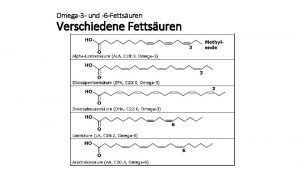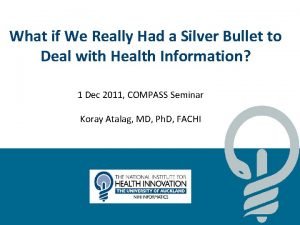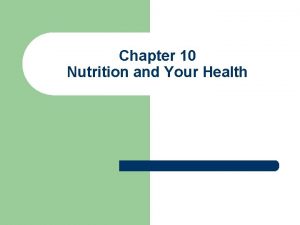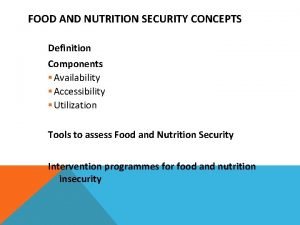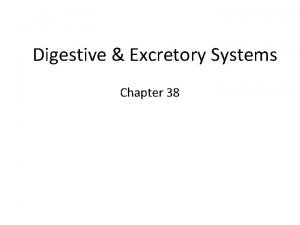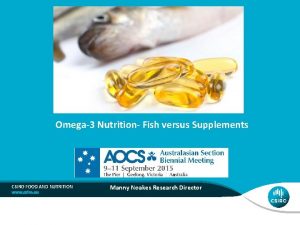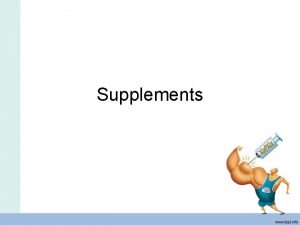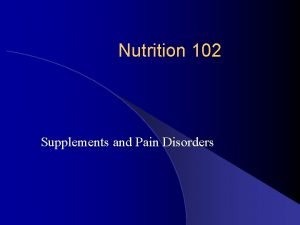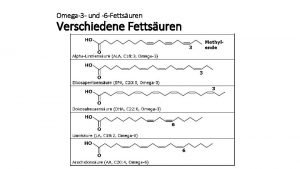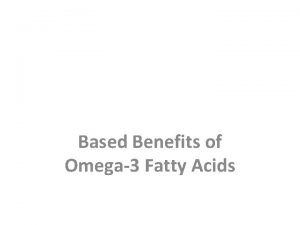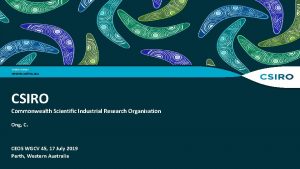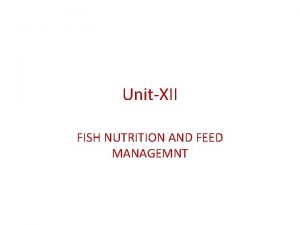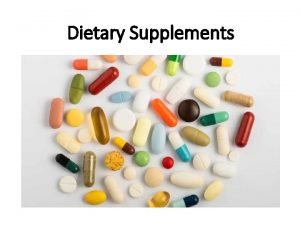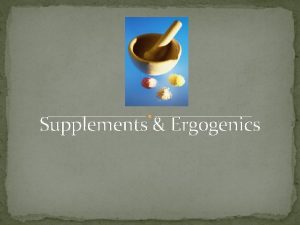Omega3 Nutrition Fish versus Supplements CSIRO FOOD AND






























- Slides: 30

Omega-3 Nutrition- Fish versus Supplements CSIRO FOOD AND NUTRITION Manny Noakes Research Director

n-3 LC PUFA intake • LC PUFA n-3 reputed wide-ranging health benefits. • Humans limited capacity to synthesize n-3 LC. • Consumption of preformed n-3 LC PUFA s needed. • Seafood best dietary source. ~20% Australians consumed fish & seafood (Aus Health Survey 2011/12) Vegan, vegetarian and non fish consumers may be very low in n-3 LC PUFA 2 | Slide from W Stonehouse

Median n-3 LC PUFA intakes (mg/day) Year of data collection Country Population Greenland Eskimos 1976 13, 000 Canada Inuit of Nunavik 1992 2115 James Bay Cree 1992 800 ∼ 2008 207 Kyushu<comma> SW island of Japan 1999 905 INTERLIPID study Aito Town 2003 810 INTERLIPID study Japanese living in Hawaii 2003 310 France All regions of France 1995 364 Nth Sth Europe 7 Centres in Europe 2003 239 Belgium Women living in Flanders 2009 199 Australia 1995 National Nutrition Survey German Nutrition Survey USA USDA Netherlands Rotterdam coronary calcification study Quebec Japan 3 | Meyer et al 2011 Median intakes (mg/day) 1995 1998 1994– 1996 1993 170 160 ∼ 115 97

Current Australian Guidelines • NHMRC nutrient reference values (NRVs) in 2006 for omega-3 LCPUFA recommending both an adequate intake 160 mg/day (men) and 90 mg/day (women) and a suggested dietary target to prevent chronic disease – 600 mg/day for men and 400 mg/day for women. • FSANZ also supports the consumption of omega-3 LCPUFA by allowing general-level health claims for heart health on commercially available food products. The food must contain a minimum of 50 mg EPA+DHA combined in a serving of food. • Australian Dietary Guidelines recommend at least 2 serves of (any) fish per week. 4 | Slide from W Stonehouse

Health Claims for Heart Health FSANZ EPA & DHA contribute to heart health EFSA • DHA & EPA contribute to normal function of the heart (0. 25 g/d) • DHA & EPA contribute to maintenance of normal blood pressure (3 g/d) • DHA & EPA contribute to maintenance of normal blood triglyceride levels (2 g/d) • DHA contributes to maintenance of normal blood triglyceride levels (2 g/d in combination with EPA) FDA Supportive but not conclusive research shows consumption of EPA & DHA omega-3 fatty acids may reduce risk of coronary heart disease. 5 | Slide from W Stonehouse

2008 6 | Recommendations



Systematic reviews – literature between 2007 -2013 FISH OIL SUPPLEMENTS • Are omega-3 LCPUFA supplements effective in the primary prevention of coronary heart disease? • Are omega-3 LCPUFA supplements an effective intervention for the secondary prevention of CHD? • Are omega-3 LCPUFA supplements effective in the prevention or treatment of heart failure? • Are omega-3 LCPUFA supplements an effective intervention for lowering plasma triglycerides in hypertriglyceridaemic patients? FISH • Is the reported consumption of omega-3 LCPUFA from fish associated with lower incidence of CHD events in primary prevention? • Is the reported consumption of fish associated with a lower incidence of CHD in patients with existing CHD (i. e. secondary prevention)? • Is the reported consumption of fish, or dietary patterns high in omega-3 LCPUFA associated with lower incidence of heart failure?

Fish Oil Studies 10 |

Are omega-3 LCPUFA supplements effective in the primary prevention of coronary heart There no current evidence that omega-3 LCPUFA disease? Kotwal etis al 2012 Level 1 • Omega 3 Fatty acids and cardiovascular outcomes: supplementation is beneficial or the primary systematic review and meta-analysis Rizos et al 2012 Level 1 CHD prevention of • Association between omega-3 fatty acid supplementation and risk of major cardiovascular disease events: a systematic review and meta-analysis Bosch et al 2012 Level 11 • n-3 fatty acids and cardiovascular outcomes in patients with dysglycemia Itakura et al 2011 Level 11 • Relationships between plasma fatty acid composition and coronary artery disease Roncaglioni et al. 2013 Level 11 • n-3 fatty acids in patients with multiple cardiovascular risk factors doses of EPA/DHA was 1 -2 g 11 |

Kotwal et al 2012 a systematic review and meta-analysis Level 1 Evidence 20 trials and >60 000 patients No effect of ω-3 fatty acids on composite cardiovascular outcomes Copyright © American Heart Association, Inc. All rights reserved.

Are omega-3 LCPUFA supplements effective in the secondary prevention of coronary heart disease? 5 Level 1 ismeta-analyses were included: Kotwal et al. ; Rizos LCPUFA There no current evidence that omega-3 et al. ; Kwak et al. ; Zhao et al. , and Marik et al. supplementation is beneficial for the secondary The two meta-analyses published prior to 2010 provided prevention of CHD evidence of benefit in patients with existing CHD, but the meta-analyses published after 2010 did not. 3. Level II RCTs included the OMEGA study (2010), Alpha to Omega study (2010) and GISSI Heart Failure (GISSI-HF) trial 2 trials provided 1 g EPA/DHA, one for 1 year (OMEGA and GISSI-HF), while the Alpha-Omega trial provided 400 mg EPA/DHA. The OMEGA trials did not find evidence of a beneficial effect 13 |

Might statins inhibit LC PUFA n-3? – possible mechanisms • de Lorgeril et al BMC Medicine 2013 • Statins increase arachidonic acid, the main n -6 fatty acid in cell membranes. • This may in turn inhibit the protective effects of n-3 because n-6 and n-3 fatty acids are in competition through various pathways involved in the development and complications of CHD. • Thus statins may inhibit n-3 by interfering in the n-3/n-6 interplay and favoring n-6. 14 |

Does Statin Use Mitigate the Benefit of Omega-3 Fatty Acids? • Seth et al. 2014 Meta-Regression of Randomized Trials • 23 studies with 38, 910 n-3 LCPUFA; 38, 866 controls. • Lower control group statin use (b = 0. 222, P = 0. 027) and higher DHA/EPA (b = -0. 105, P = 0. 033) ratio was associated with higher reduction in total mortality. Statin use may mitigate, and higher DHA/EPA ratio is associated with the beneficial effect of PUFA supplementation. 15 |

Are omega-3 LCPUFA supplements effective in the prevention or treatment of heart failure? GISSI-HF 7, 000 benefit patientsfrom with functional There is trial modest 1 g n-3 Class II to IV heart failure were randomised to 1 g/day LCPUFA in heart and in particular or placebo. Over a 3. 9 -year median follow-up, in those with greater absolute CHD risk. supplementation resulted in an absolute 9% reduction in mortality or admission to hospital (p=0. 04). Benefit was greater in elderly and diabetic patients and those with impaired left ventricular function (sub-groups with greater absolute risk). Around 300, 000 Australians are living with heart failure, and every year around another 30, 000 people are newly diagnosed with it 16 |

Are omega-3 LCPUFA effective for lowering plasma triglycerides in hypertriglyceridaemic patients? 2 These positivedata meta-analyses confirm high doses n-3 • LCPUFA Hartweg et andfor Reiner et al. 2011 asala 2007 means lowering plasma triglyceride levels. Effective Dosage: • Starting with 1200 mg/day DHA+EPA Increase if needed to: • 4000 mg/day • Checking patient’s response every 3 -4 weeks when the dose is changed, until target TG levels reached. 17 |

Do Omega-3 LCPUFA Alter the Risk or Incidence of High Blood Pressure? • 3 meta-analyses Appel et al 1993, Geleijnse et al 2002, Morris et al 1993 have shown that omega-3 LCPUFA reduce BP with the greatest effect in hypertensive patients -3. 4 to -5. 5 mm. Hg systolic BP -2. 0 to -3. 5 mm. Hg diastolic BP • Dokholyan et al. 2004 also suggested that greater than >3 g/day n-3 LCPUFA is required to reduce BP in patients with highnormal diastolic BP or stage 1 hypertension. Mori et al. showed that in overweight, mildlyhypercholesterolaemic patients, 4 g/day of encapsulated DHA, but not EPA, reduced 24 -hour BP by -5. 8/-3. 3 mm. Hg. 18 |

EPA/DHA and blood pressure: a meta-analysis. Miller et al 2014 • Effect of EPA+DHA on blood pressure in RCTs. • 70 RCTs were included. • The strongest effects in untreated hypertensives systolic blood pressure = -4. 51 mm Hg diastolic blood pressure = -3. 05 mm Hg • BP also lowered among normotensives Provision of EPA+DHA systolic blood pressure = -1. 25 reduces mm Hg systolic BP, while provision of ≥ 2 g omega 3 LCPUFA reduces diastolic BP. diastolic blood pressure = -0. 62 mm Hg 19 |

Omega-3 and LCPUFA Rheumatoid Arthritis • Patient-assessed pain, morning stiffness, number of painful and/or tender joints and non-steroidal antiinflammatory drug (NSAID) consumption • Large dosages EPA+DHA (>3 g/d) needed for 3 months to see symptomatic benefits. • 1 yr trial, 5. 5 g EPA+DHA/d – st lower failure rate of 1 -line therapy (Proudman et al. 2015) |

n-3 LCPUFA and Cognition Suggestive evidence DHA enhances learning and cognitive development in children; memory and reaction time • 3 Meta-analyses – n-3 LCPUFA particularly: improved memory, attention & • Individuals with low habitual intake processing speed in adults with of LC n-3 mild cognitive impairment / age • Children with low literacy ability -related cognitive decline • Age-related cognitive decline Stonehouse et al 2013 Stonehouse et al 2014 21 | Slide from W Stonehouse Yurko-Mauro et al 2015 Mazereeuw et al 2012 Cooper et al 2015

n-3 LCPUFA & Depression Meta-analysis (Martins, 2009): • Symptoms of depression significantly reduced with pure ethyl-EPA and high EPA (>50%) supplements. • No effects seen with pure DHA or high DHA (>50%) supplements. • Greatest effects in therapeutic populations (bipolar disorder and major depression) vs. mild-to-moderate depression • Dose-response effect. 22 |

n-3 LCPUFA in depression • Sublette et al 2011 - 15 trials 916 participants • % EPA in the supplements was the fixed-effect predictor, dichotomized into 2 groups: EPA < 60% or EPA ≥ 60% of the total EPA + DHA • Supplements with EPA ≥ 60% showed benefit on standardized mean depression scores (effect size = 0. 532; P <. 001) versus supplements with EPA < 60% (effect size = -0. 026; P =. 756) • Supplements with EPA < 60% were ineffective. Supplements containing EPA ≥ 60% of total EPA + DHA, in a dose range of 200 to 2, 200 mg/d of EPA in excess of DHA, were effective against primary depression. 23 |

Fish/Dietary Studies 24 |

Is consumption of omega-3 LCPUFA from fish associated with lower incidence of CHD events in primary prevention? Prospective cohort studies • de Goede et al , 2010 Marine (n-3) fatty acids, fish consumption, and the 10 -year risk of fatal and nonfatal coronary heart disease in a large population of Dutch adults with low fish intake • Joensen et al 2011 Marine n-3 polyunsaturated fatty acids in adipose tissue and the risk of acute coronary syndrome • Mozaffarian et al 2013 Plasma phospholipid longchain omega-3 fatty acids and total and causespecific mortality in older adults: a cohort study • Musa-Veloso et al. 2011 Impact of low v. moderate intakes of long-chain n-3 fatty acids on risk of coronary heart disease – benefit with >250 mg omega-3 LCPUFA from fish reducing the risk of sudden cardiac death by 35% • Streppel et al 2008 Long-term fish consumption and n-3 fatty acid intake in relation to (sudden) coronary heart disease death: the Zutphen study There is good evidence that increased consumption of fish or dietary patterns with omega-3 LCPUFA are associated with the primary prevention of coronary heart disease (Level 111) 25 |

Is consumption of fish associated with lower incidence of heart failure? Prospective cohort studies observational data are supportive • These Meta-analysis -7 prospective cohort studies - of a modest inverse fish 176, 441 association subjects withbetween 5, 480 cases of consumption heart failure. and High fish intake. Level protective against developing HF. heart failure. III • Cardiovascular Health Study - 4, 738 US adults >65 y. Highest quintile had 32% lower risk compared to those who consumed fish < or = to 1/month (p trend 0. 009). • A 14. 3 -year follow-up -The Atherosclerosis Risk in Communities (ARIC) study - plasma phospholipid omega-3 LCPUFA (especially EPA) at baseline inversely correlated with heart failure in women but not in men (P<0. 001). 26 |

Is consumption of fish associated with lower CHD in patients with existing CHD (i. e. secondary prevention)? Evidence support s the consumption Evidence from prospective cohort studies of fish oilystudies. fish for Only twoincluding applicable new secondary prevention of CHD. Level III Manger et al. 2010, Dietary intake of n-3 long-chain PUFA and coronary events in Norwegian patients with coronary artery disease. Pottala et al 2010 Blood EPA and DHA predict all-cause mortality in patients with stable coronary heart disease: the Heart and Soul study. 27 |

Are Omega-3 LCPUFA from Fish Associated with Lower Stroke Risk? • Mozaffarian et al. (2013) reported total plasma phospholipid omega-3 LCPUFA were inversely These data suggest that fish intake related to ischaemic stroke risk (p=0. 043) with a associated with lower stroke risk. 37% reduction in the highest versus the lowest quintile, but there was no significant effect on haemorrhagic stroke (p=0. 86). • DHA most strongly associated with reduction in ischaemic stroke and DPA with reduction in stroke death. • Larsson et al. , meta-analysis of fish consumption and stroke in 15 prospective studies, - increment of 3 servings of fish/week associated with a 6% lower incidence of total stroke. • Interventions with fish oil supplementation have not demonstrated any reduction in stroke. 28 | is

Key Findings: Omega-3 LCPUFA supplements - neither a beneficial nor adverse effect demonstrated in primary or secondary prevention of CHD. • The evidence continues to be positive for the role of omega-3 LCPUFA in the treatment of hypertriglyceridaemia • The evidence continues to be positive for the role of omega-3 LCPUFA as a benefit to prevent heart failure. • Higher fish intake was associated with lower incident rates of heart failure in addition to lower sudden cardiac death, stroke and myocardial infarction.

2015 Recommendations FISH • Dietary intake of fish consistently found to be of benefit for the protection from heart disease and stroke. Higher fish intake was associated with lower incident rates of heart failure, o lower sudden cardiac death, stroke and myocardial infarction. • Heart Foundation recommends all Australians include 2 -3 three serves fish (including oily fish)/week as part of a heart healthy eating pattern. • This amount of fish provides between 250 -500 mg per day of combined docosahexaenoic acid (DHA) and eicosapentaenoic acid (EPA). SUPPLEMENTS • Omega-3 LCPUFA supplements can be considered in patients with heart failure in additional to standard therapy. • Omega-3 LCPUFA supplements are effective in the treatment of hypertriglyceridaemia. 30 |
 One fish two fish red fish blue fish ride
One fish two fish red fish blue fish ride Soil organic matter
Soil organic matter Omega3
Omega3 One fish, two fish, blowfish, blue fish
One fish, two fish, blowfish, blue fish Ammocoete
Ammocoete Field hockey supplements
Field hockey supplements Dietary supplements meaning
Dietary supplements meaning Unit 3 lesson 4 proving angles congruent
Unit 3 lesson 4 proving angles congruent Spiritual supplements
Spiritual supplements When to take supplements chart
When to take supplements chart Planmeca cio
Planmeca cio Gri sector supplements
Gri sector supplements Biotest testosterone booster
Biotest testosterone booster A big fish swims up and swallows a small fish at rest
A big fish swims up and swallows a small fish at rest Diagram of male and female reproductive system of fish
Diagram of male and female reproductive system of fish Cartilaginous vs bony fish
Cartilaginous vs bony fish Live shellfish market form
Live shellfish market form Digital illuminate aqa food preparation and nutrition
Digital illuminate aqa food preparation and nutrition Lesson 4 nutrition labels and food safety
Lesson 4 nutrition labels and food safety Food and nutrition unit 4
Food and nutrition unit 4 Section 38-1 food and nutrition
Section 38-1 food and nutrition Food and nutrition unit 5
Food and nutrition unit 5 38-1 food and nutrition
38-1 food and nutrition Chapter 10 lesson 4 nutrition labels and food safety
Chapter 10 lesson 4 nutrition labels and food safety Chapter 10 lesson 4 nutrition labels and food safety
Chapter 10 lesson 4 nutrition labels and food safety Usda food and nutrition service
Usda food and nutrition service Food and nutrition unit 5
Food and nutrition unit 5 Labour saving devices in food and nutrition
Labour saving devices in food and nutrition Nutrition security definition
Nutrition security definition Section 38-2 the process of digestion answer key
Section 38-2 the process of digestion answer key Aqa food preparation and nutrition nea 2 examples
Aqa food preparation and nutrition nea 2 examples


